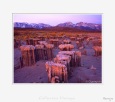
Mono Lake is believed to have formed at least 760,000 years ago, dating back to the Long Valley eruption. Sediments located below the ash layer hint that Mono Lake could be a remnant of a larger and older lake that once covered a large part of Nevada and Utah, making it among the oldest lakes in North America.
Mono Lake is a terminal lake in a watershed fed from melting runoff with no outlet. Dissolved salts in the runoff thus remain in the lake and raise the pH and the salt concentration.
Mono Lake is in a geologically active area at the north end of the Mono-Inyo Crater volcanic chain of the Long Valley Caldera. The geological activity is caused by faulting at the base of the Sierra Nevada, and is associated with the crustal stretching of the Basin and Range Province.
Volcanic activity continues in the Mono Lake vicinity: the most recent eruption occurred 250 years ago at Negit Island in Mono Lake. Panum Crater (on the south shore of the lake) is an excellent example of a combined rhyolite dome and cinder cone.
 The hypersalinity and high alkalinity (pH=10 or equivalent to 2.5 grams
of NaOH per liter of water) of the lake, means that no fish
are native to the lake. An attempt by the California Department
of Fish and Game to stock the lake failed. The lake is famous
for the Mono Lake brine shrimp, Artemia monica, a tiny species
of brine shrimp, no bigger than a thumbnail, that are found
nowhere else on earth. During the warmer summer months, an
estimated 4-6 trillion brine shrimp inhabit the lake. The brine
shrimp feed on microscopic planktonic algae which reproduce
rapidly during winter and early spring after winter runoff
brings nutrients to the surface layer of water. By March the
lake is "as
green as pea soup" with photosynthesizing algae. Brine shrimp
has no food value for humans, but is a staple for birds of
the region. Also an important food source, alkali flies ("Ephydra
hians")
live along the shores of the lake and walk underwater encased
in small air bubbles to graze and to lay eggs. The whole food
chain of the lake is based on the high population of single-celled
algae present in the warm shallow waters. (Source
Wikipedia)
The hypersalinity and high alkalinity (pH=10 or equivalent to 2.5 grams
of NaOH per liter of water) of the lake, means that no fish
are native to the lake. An attempt by the California Department
of Fish and Game to stock the lake failed. The lake is famous
for the Mono Lake brine shrimp, Artemia monica, a tiny species
of brine shrimp, no bigger than a thumbnail, that are found
nowhere else on earth. During the warmer summer months, an
estimated 4-6 trillion brine shrimp inhabit the lake. The brine
shrimp feed on microscopic planktonic algae which reproduce
rapidly during winter and early spring after winter runoff
brings nutrients to the surface layer of water. By March the
lake is "as
green as pea soup" with photosynthesizing algae. Brine shrimp
has no food value for humans, but is a staple for birds of
the region. Also an important food source, alkali flies ("Ephydra
hians")
live along the shores of the lake and walk underwater encased
in small air bubbles to graze and to lay eggs. The whole food
chain of the lake is based on the high population of single-celled
algae present in the warm shallow waters. (Source
Wikipedia)
© 1998-2025 - C. Cassegrain Photograph - All rights reserved v.05 - Mobile : +33 6 71 26 04 76 |